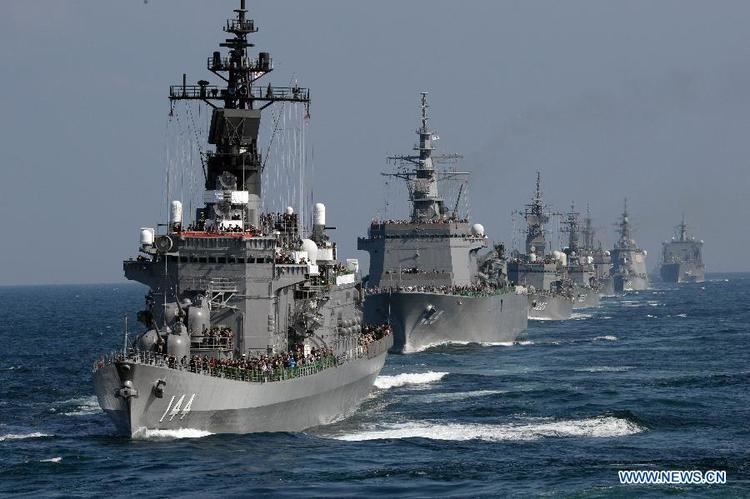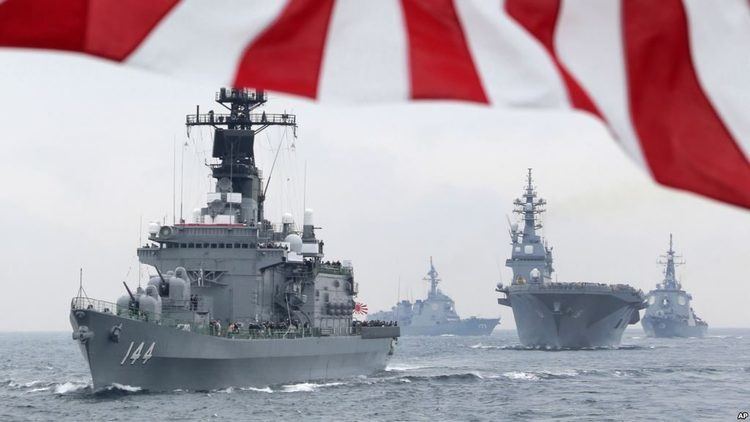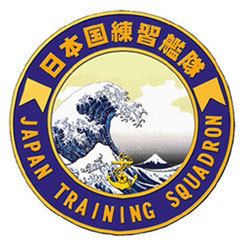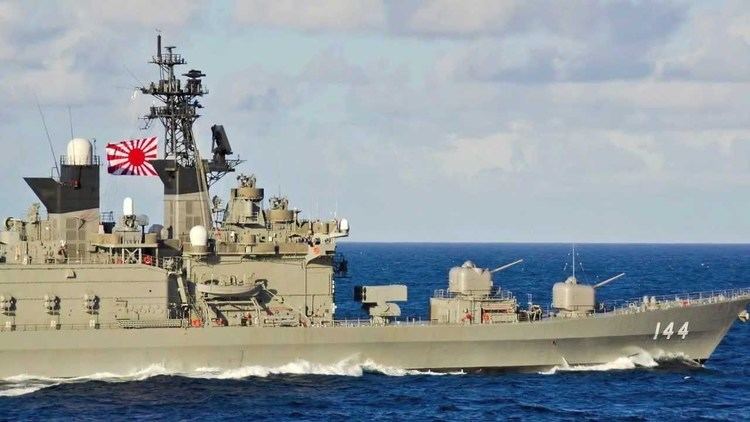Country Japan Garrison/HQ Yokosuka, Japan Commander-in-Chief PM Shinzō Abe Headquarters Yokosuka Fleet 19 | Type Navy Website www.mod.go.jp/msdf Founded 1 July 1954, Japan Minister of defense Tomomi Inada | |
 | ||
Size 50,800 personnel154 ships346 aircraft Similar Japan Self‑Defense Forces, Japan Ground Self‑Defe, Japan Air Self‑Defense Force, Imperial Japanese Navy, People's Liberation Army Navy Profiles | ||
The Japan Maritime Self-Defense Force (海上自衛隊, Kaijō Jieitai), or JMSDF, is the naval branch of the Japan Self-Defense Forces, tasked with the naval defense of Japan. It was formed following the dissolution of the Imperial Japanese Navy (IJN) after World War II. The JMSDF has a fleet of 154 ships and 346 aircraft. Its main tasks are to maintain control of the nation's sea lanes and to patrol territorial waters. It also participates in UN-led peacekeeping operations (PKOs) and Maritime Interdiction Operations (MIOs).
Contents
- Japan maritime self defense force jmsdf show of force
- Origin
- Imperial Japanese Navy
- Japanese Maritime Self Defense Force
- Post Cold War
- Capabilities and recent developments
- Mission in the Indian Ocean
- Mission in Somalia
- Military exercises and exchanges
- Ships and submarines
- Aircraft
- Organization formations and structure
- District Forces
- Fleet Air Force
- Special Forces
- Ranks
- Culture and naming conventions
- Recruitment and training
- References

Japan maritime self defense force jmsdf show of force
Origin

Japan has a long history of naval interaction with the Asian continent, involving the transportation of troops, starting at least with the beginning of the Kofun period in the 3rd century. Following the attempts at Mongol invasions of Japan by Kublai Khan in 1274 and 1281, Japanese wakō became very active in plundering the coast of the Chinese Empire.

Japan undertook major naval building efforts in the 16th century, during the Warring States period, when feudal rulers vying for supremacy built vast coastal navies of several hundred ships. Around that time, Japan may have developed one of the world's first ironclad warships, when Oda Nobunaga (a Japanese daimyo) had six iron-covered Oatakebune made in 1576.

In 1588, Toyotomi Hideyoshi issued a ban on Wakō piracy; the pirates then became vassals of Hideyoshi and comprised the naval force used in the Japanese invasion of Korea.
Japan built her first large ocean-going warships in the beginning of the 17th century, following contact with European countries during the Nanban trade period. In 1613, the Daimyo of Sendai, in agreement with the Tokugawa Bakufu, built the Date Maru. This 500 ton galleon-type ship transported the Japanese embassy of Hasekura Tsunenaga to the Americas and Europe. From 1604 onwards, about 350 Red seal ships, usually armed and incorporating European technology, were also commissioned by the Bakufu, mainly for Southeast Asian trade.
Imperial Japanese Navy
From 1868, the restored Meiji Emperor continued with reforms to industrialize and militarize Japan to prevent the United States and European powers from overwhelming it. On 17 January 1868, the Ministry of Military Affairs was established, with Iwakura Tomomi, Shimazu Tadayoshi and Prince Komatsu-no-miya Akihito as the First Secretaries.
On 26 March 1868, the first Naval Review was held in Japan (in Osaka Bay), with 6 ships from the private domainal navies of Saga, Chōshū, Satsuma, Kurume, Kumamoto and Hiroshima participating. The total tonnage of these ships was 2252 tons, far smaller than the tonnage of the single foreign vessel (from the French Navy) that also participated. In July 1869, the Imperial Japanese Navy was formally established, two months after the last military engagement of the Boshin War – the private navies of the Japanese nobles were abolished and their 11 ships were added to the 7 surviving vessels of the defunct Tokugawa bakufu navy, including the Kankō Maru, Japan's first steam warship. This formed the core of the new Imperial Japanese Navy.
An 1872 edict officially separated the Japanese Navy from the Japanese Army. Politicians like Enomoto Takeaki set out to use the Navy to expand to the islands south of Japan in similar fashion to the Army's northern and western expansion. The Navy sought to upgrade its fleet to a blue water navy and used cruises to expand the Japanese consciousness on the southern islands. Enomoto's policies helped the Navy expand and incorporate many different islands into the Japanese Empire, including Iwo Jima in 1889. The navy continued to expand and incorporate political influence throughout the early twentieth century.
Japanese Maritime Self-Defense Force
Following Japan's defeat in World War II, the Imperial Japanese Navy was dissolved by the Potsdam Declaration acceptance. Ships were disarmed, and some of them, such as the battleship Nagato, were taken by the Allied Powers as reparation. The remaining ships were used for repatriation of the Japanese soldiers from abroad and also for minesweeping in the area around Japan, initially under the control of the Second Bureau of the Demobilization Ministry. The minesweeping fleet was eventually transferred to the newly formed Maritime Safety Agency, which helped maintain the resources and expertise of the navy.
Japan's 1947 Constitution was drawn up after the conclusion of the war, Article 9 specifying that "The Japanese people forever renounce war as a sovereign right of the nation and the threat or use of force as a means of settling international disputes." The prevalent view in Japan is that this article allows for military forces to be kept for the purposes of self-defense. Due to Cold War pressures, the United States was also happy for Japan to provide part of its own defense, rather than have it fully rely on American forces.
In 1952, the Coastal Safety Force was formed within the Maritime Safety Agency, incorporating the minesweeping fleet and other military vessels, mainly destroyers, given by the United States. In 1954, the Coastal Safety Force was separated, and the JMSDF was formally created as the naval branch of the Japanese Self-Defense Force (JSDF), following the passage of the 1954 Self-Defense Forces Law.
The first ships in the JMSDF were former US Navy destroyers, transferred to Japanese control in 1954. In 1956, the JMSDF received its first domestically produced destroyer since World War II, Harukaze. Due to the Cold War threat posed by the Soviet Navy's sizable and powerful submarine fleet, the JMSDF was primarily tasked with an anti-submarine role.
Post Cold War
Following the end of the Cold War, the role of the JMSDF has vastly changed. In 1991, after much international pressure, the JMSDF dispatched 4 minesweepers, a fleet oiler (JDS Tokiwa) and a minesweeping tender (JDS Hayasse) to the Persian Gulf in the aftermath of the Gulf War, under the name of Operation Gulf Dawn, to clear mines sown by Saddam Hussein's defending forces; and starting with a mission to Cambodia in 1993 when JSDF personnel were supported by JDS Towada, it has been active in a number of UN-led peace keeping operations throughout Asia. In 1993, it commissioned its first Aegis-equipped destroyer, Kongō. It has also been active in joint naval exercises with other countries, such as the United States. The JMSDF has dispatched a number of its destroyers on a rotating schedule to the Indian Ocean in an escort role for allied vessels as part of the UN-led Operation Enduring Freedom.
With an increase in tensions with North Korea following the 1993 test of the Nodong-1 missile and the 1998 test of the Taepodong-1 missile over northern Japan, the JMSDF has stepped up its role in air defense. A ship-based anti-ballistic missile system was successfully test-fired on 18 December 2007 and has been installed on Japan's Aegis-class destroyers. The JMSDF, along with the Japan Coast Guard, has also been active in preventing North Korean infiltrators from reaching Japan and in December 2001, engaged and sank a North Korean spy ship.
Capabilities and recent developments
The JMSDF has an official strength of 50,000 personnel, but presently numbers around 50,800 active personnel. As a result of continuing effective defense investment due to Japan's economic development and an end to the Cold War, The JMSDF is currently the world's fifth largest naval power. Japan has the seventh largest Exclusive Economic Zone (EEZ) in the world, and the JMSDF is responsible for protecting this large area. As an island nation, dependent on maritime trade for the majority of its resources, including food and raw materials, maritime operations are a very important aspect of Japanese defense policy.
The JMSDF is known in particular for its anti-submarine warfare and minesweeping capabilities. Defense planners believe the most effective approach to combating hostile submarines entails mobilizing all available weapons, including surface combatants, submarines, patrol planes, and helicopters. Historically the Japan Air Self-Defense Force (JASDF) has been relied on to provide air cover at sea, a role that is subordinate to the JASDF's primary mission of air defense of the home islands. Extended patrols over sea lanes are beyond the JASDF's current capabilities.
The Japanese fleet's capacity to provide ship-based antiaircraft warfare protection is limited by the absence of aircraft carriers, though its destroyers and frigates equipped with the Aegis combat system provide a formidable capability in antiaircraft and antimissile warfare. These capabilities are force multipliers, allowing force projection of Japan's sizable destroyer and frigate force far from home waters, and acquiring them is contentious considering Japan's "passive" defense policy.
In August 2003, a new "helicopter carrier" class was ordered, the Hyūga-class helicopter destroyer. The size and features of the ship, including a full-length flight deck, will result in it being classified as either an amphibious assault ship or a helicopter carrier by Lloyd's Register — similar to the United Kingdom's HMS Ocean. It has been widely argued about whether an aircraft carrier of any kind would be technically prohibited by Article 9 of the Japanese Constitution, since aircraft carriers are generally considered offensive weapons. In a Japanese Diet budget session in April 1988, the chief of the Japanese Defense Agency, Tsutomu Kawara, said, "The Self-Defense Forces are not allowed to possess ICBMs (intercontinental ballistic missiles), strategic bombers, or attack aircraft carriers."
Historically, up through about 1975 in the U.S. Navy, the large-scale carriers had been classified as "attack aircraft carriers" and the smaller carriers as "anti-submarine aircraft carriers." Since helicopter carriers have very little built-in attack capability and they primarily fulfill roles such as defensive anti-submarine warfare, the Japanese government continues to argue that the prohibition does not extend to the new helicopter carriers.
In November 2009, the JMSDF announced plans for an even larger "helicopter carrier", the Izumo-class helicopter destroyer. The first one of these ships was laid down in 2012 and was launched on 6 August 2013.
The submarine fleet of the JMSDF consists of some of the most technologically advanced diesel-electric submarines in the world. This is due to careful defense planning in which the submarines are routinely retired from service ahead of schedule and replaced by more advanced models. In 2010 it was announced that the Japanese submarine fleet would be increased in size for the first time in 36 years.
After a meeting between the Japanese Foreign Minister and U.S. Ambassador to Japan on 4 March 2014, the Japanese Defense Ministry and U.S. Department of Defense announced they would hold studies for the joint development of the littoral vessel under the bilateral Mutual Defense Assistance agreement. The vessel is planned to be a high-speed trimaran designed for operations in shallow coastal waters capable of carrying helicopters, possibly a lighter variant of the American 3,000 tonne (3,300 short ton) Littoral Combat Ship. The study is in response to the growth of the Chinese People's Liberation Army Navy and budgetary issues with the U.S. military that may affect their ability to operate in the Pacific. The J-LCS would be used to intervene during Chinese ship incursions near the Senkaku Islands and other contested areas in the East China Sea, and possibly counter similar Chinese vessels like the Type 056 corvette and Type 022 missile boat. A 1,000 tonnes (980 long tons; 1,100 short tons) J-LCS with an enlarged hull could operate the SH-60K anti-submarine helicopter or the MCH-101 airborne mine countermeasures (AMCM) helicopter.
Mission in the Indian Ocean
Destroyers and combat support ships of Japan Maritime Self-Defense Force were dispatched to the Indian Ocean from 2001 to 2008 to participate in OEF-MIO (Operation Enduring Freedom-Maritime Interdiction Operation). Their mission is to prevent the marine transportation of illegal weapons and ammunition, and the drugs which fund terrorist activity. Since 2004, the JMSDF has provided ships of foreign forces with fuel for their ships and ship-based helicopters, as well as fresh water.
This was the third time Japanese military vessels had been dispatched overseas since World War II, following the deployments of mine-sweeping units during the Korean War and the Persian Gulf War. The law enabling the mission expired on 2 November 2007, and the operation was temporarily canceled due to a veto of a new bill authorizing the mission by the opposition-controlled upper chamber of the Japanese Diet.
In January 2010, the defense minister ordered the JMSDF to return from the Indian Ocean, fulfilling a government pledge to end the eight-year refueling mission. Prime Minister Yukio Hatoyama refused to renew the law authorizing the mission, ignoring requests from the American government for continuation. Both the Western alliance country typified by the Royal Australian Navy and the Royal Danish Navy, doing friendship activities in the Indian Ocean .
Mission in Somalia
In May 2010, Japan announced its intention to build a permanent naval base in Djibouti, from which it will conduct operations to protect merchant shipping from Somali pirates.
Military exercises and exchanges
The JMSDF and the U.S. Navy frequently carry out joint exercises and "U.S. Navy officials have claimed that they have a closer daily relationship with the JMSDF than any other navy in the world". The JMSDF participates in RIMPAC, the annual multi-national military exercise near Hawaii that has been hosted by the U.S. Navy since 1980. The JMSDF dispatched a ship to the Russian Vladivostok harbor in July 1996 to participate in the Russian Navy's 300th anniversary naval review. Vladimir Vinogradov came by ship to the Tokyo harbor in June 1997. The JMSDF has also conducted joint naval exercises with the Indian Navy.
Ships and submarines
The ship prefix JDS (Japanese Defense Ship) was used until 2008, at which time JMSDF ships started using the prefix JS (Japanese Ship) to reflect the upgrade of the Japanese Defense Agency to the Ministry of Defense. As of 2014, the JMSDF operates a total of 124 ships (excluding minor auxiliary vessels), including; four helicopter carriers (called helicopter destroyers), 26 destroyers, 10 small destroyers (or frigates), six destroyer escorts (or corvettes), 18 attack submarines, 29 mine countermeasure vessels, six patrol vessels, three landing ship tanks, eight training vessels and a fleet of various auxiliary ships. The fleet has a total displacement of approximately 450,000 tonnes (including auxiliary vessels).
Aircraft
The Japan Maritime Self-Defense Force aviation maintains a large naval air force, including 201 fixed-wing aircraft and 145 helicopters. Most of these aircraft are used in anti-submarine warfare operations.
Organization, formations and structure
The JMSDF is commanded by the Chief of the Maritime Staff (currently Katsutoshi Kawano). Its structure consists of the Maritime Staff Office, the Self Defense Fleet, five regional district commands, the air-training squadron and various support units, such as hospitals and schools. The Maritime Staff Office, located in Tokyo, serves the Chief of Staff in commanding and supervising the force.
The Self-Defense Fleet, headquartered at Yokosuka, consists of the JMSDF's military shipping. It is composed of four Escort Flotillas (based in Yokosuka, Sasebo, Maizuru and Kure), the Fleet Air Force headquartered at Atsugi, two Submarine Flotillas based at Kure and Yokosuka, two Mine-sweeping Flotillas based at Kure and Yokosuka and the Fleet Training Command at Yokosuka.
Each Escort Flotilla is formed as an 8–8 fleet of 8 destroyers and 8 on-board helicopters, a modification of the old Japanese Navy fleet layout of 8 battleships and 8 cruisers. Each force is composed of one helicopter destroyer (DDH) acting as a command ship, two guided-missile destroyers (DDG) and 5 standard or ASW destroyers (DD). The JMSDF is planning to reorganize the respective Escort Flotillas into a DDH group and DDG group, enabling faster overseas deployments.
District Forces
Five district units act in concert with the fleet to guard the waters of their jurisdictions and provide shore-based support. Each district is home to a major JMSDF base and its supporting troops and staff. Furthermore, each district is home to one or two regional escort squadrons, composed of two to three destroyers or destroyer escorts (DE). The destroyers tend to be of older classes, mainly former escort force ships. The destroyer escorts, on the other hand, tend to be purpose built vessels. Each district also has a number of minesweeping ships.
Fleet Air Force
The Fleet Air Force is tasked with patrol, ASW and rescue tasks. It is composed primarily of 7 aviation groups. Prominent bases are maintained at Kanoya, Hachinohe, Atsugi, Naha, Tateyama, Oomura and Iwakuni. The Fleet Air Force is built up mainly with patrol aircraft such as the Lockheed P-3 Orion, rescue aircraft such as the US-1A and helicopters such as the SH-60J. In the JMSDF, helicopters deployed to each escort force are actually members of Fleet Air Force squadrons based on land.
Special Forces
Special Forces units consist of the following:
Ranks
The following details the officer ranks of the JMSDF, showing the Japanese rank, the English translation and the NATO equivalent.
Ranks are listed with the lower rank at right.
Culture and naming conventions
Although Japan's Ground Self-Defense Force has almost dropped traditions associated with the Imperial Japanese Army save for the march music tradition (Review March is the official march of the IJA and today's JGSDF), the JMSDF has maintained these historic links with the Imperial Japanese Navy (IJN). Today's JMSDF continues to use the same martial songs, naval flags, signs, and technical terms as the IJN. For example, the official flag of the JMSDF is the same as that used by the IJN. Also, the JMSDF tradition of eating Japanese curry every Friday lunch originated with the IJN. The JMSDF still uses the Warship March, the old service march of the IJN, as its official service march. It also maintains the IJN bugle calls tradition, as every ship and shore establishment command maintain a platoon or squad of bugle players.
The ship prefix JDS (Japanese Defense Ship) was used until 2008, at which time JMSDF ships started using the prefix JS (Japanese Ship) to reflect the upgrade of the Japanese Defense Agency to the Ministry of Defense.
Ships of the JMSDF, known as Japan Ships (自衛艦; Ji'ei-Kan), are classified according to the following criteria:
Recruitment and training
JMSDF recruits receive three months of basic training followed by courses in patrol, gunnery, mine sweeping, convoy operations and maritime transportation. Flight students, all upper-secondary school graduates, enter a two-year course. Officer candidate schools offer six-month courses to qualified enlisted personnel and those who have completed flight school.
Graduates of four-year universities, the four-year National Defense Academy, and particularly outstanding enlisted personnel undergo a one-year officer course at the Officer Candidate School at Etajima (site of the former Imperial Naval Academy). The JMSDF also operates a staff college in Tokyo for senior officers.
The large volume of coastal commercial fishing and maritime traffic around Japan limits in-service sea training, especially in the relatively shallow waters required for mine laying, mine sweeping and submarine rescue practice. Training days are scheduled around slack fishing seasons in winter and summer—providing about ten days during the year.
The JMSDF maintains two oceangoing training ships and conducted annual long-distance on-the-job training for graduates of the one-year officer candidate school.
